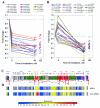Responses of the Rhodobacter sphaeroides transcriptome to blue light under semiaerobic conditions
- PMID: 15516587
- PMCID: PMC524910
- DOI: 10.1128/JB.186.22.7726-7735.2004
Responses of the Rhodobacter sphaeroides transcriptome to blue light under semiaerobic conditions
Abstract
Exposure to blue light of the facultative phototrophic proteobacterium Rhodobacter sphaeroides grown semiaerobically results in repression of the puc and puf operons involved in photosystem formation. To reveal the genome-wide effects of blue light on gene expression and the underlying photosensory mechanisms, transcriptome profiles of R. sphaeroides during blue-light irradiation (for 5 to 135 min) were analyzed. Expression of most photosystem genes was repressed upon irradiation. Downregulation of photosystem development may be used to prevent photooxidative damage occurring when the photosystem, oxygen, and high-intensity light are present simultaneously. The photoreceptor of the BLUF-domain family, AppA, which belongs to the AppA-PpsR antirepressor-repressor system, is essential for maintenance of repression upon prolonged irradiation (S. Braatsch et al., Mol. Microbiol. 45:827-836, 2002). Transcriptome data suggest that the onset of repression is also mediated by the AppA-PpsR system, albeit via an apparently different sensory mechanism. Expression of several genes, whose products may participate in photooxidative damage defense, including deoxypyrimidine photolyase, glutathione peroxidase, and quinol oxidoreductases, was increased. Among the genes upregulated were genes encoding two sigma factors: sigmaE and sigma38. The consensus promoter sequences for these sigma factors were predicted in the upstream sequences of numerous upregulated genes, suggesting that coordinated action of sigmaE and sigma38 is responsible for the upregulation. Based on the dynamics of upregulation, the anti-sigmaE factor ChrR or its putative upstream partner is proposed to be the primary sensor. The identified transcriptome responses provided a framework for deciphering blue-light-dependent signal transduction pathways in R. sphaeroides.
Figures



Similar articles
-
Transcriptome analysis of the Rhodobacter sphaeroides PpsR regulon: PpsR as a master regulator of photosystem development.J Bacteriol. 2005 Mar;187(6):2148-56. doi: 10.1128/JB.187.6.2148-2156.2005. J Bacteriol. 2005. PMID: 15743963 Free PMC article.
-
Light-dependent regulation of photosynthesis genes in Rhodobacter sphaeroides 2.4.1 is coordinately controlled by photosynthetic electron transport via the PrrBA two-component system and the photoreceptor AppA.Mol Microbiol. 2005 Nov;58(3):903-14. doi: 10.1111/j.1365-2958.2005.04882.x. Mol Microbiol. 2005. PMID: 16238636
-
Transcriptome and physiological responses to hydrogen peroxide of the facultatively phototrophic bacterium Rhodobacter sphaeroides.J Bacteriol. 2005 Nov;187(21):7232-42. doi: 10.1128/JB.187.21.7232-7242.2005. J Bacteriol. 2005. PMID: 16237007 Free PMC article.
-
Generalized approach to the regulation and integration of gene expression.Mol Microbiol. 2001 Mar;39(5):1116-23. doi: 10.1111/j.1365-2958.2001.02299.x. Mol Microbiol. 2001. PMID: 11251830 Review.
-
Singlet oxygen stress in microorganisms.Adv Microb Physiol. 2011;58:141-73. doi: 10.1016/B978-0-12-381043-4.00004-0. Adv Microb Physiol. 2011. PMID: 21722793 Review.
Cited by
-
The AppA and PpsR proteins from Rhodobacter sphaeroides can establish a redox-dependent signal chain but fail to transmit blue-light signals in other bacteria.J Bacteriol. 2007 Mar;189(6):2274-82. doi: 10.1128/JB.01699-06. Epub 2007 Jan 5. J Bacteriol. 2007. PMID: 17209035 Free PMC article.
-
Ecology, diversity, and evolution of magnetotactic bacteria.Microbiol Mol Biol Rev. 2013 Sep;77(3):497-526. doi: 10.1128/MMBR.00021-13. Microbiol Mol Biol Rev. 2013. PMID: 24006473 Free PMC article. Review.
-
Transcriptome profiling of the C. elegans Rb ortholog reveals diverse developmental roles.Dev Biol. 2007 May 15;305(2):674-84. doi: 10.1016/j.ydbio.2007.02.021. Epub 2007 Feb 21. Dev Biol. 2007. PMID: 17368442 Free PMC article.
-
Salt stress-induced changes in the transcriptome, compatible solutes, and membrane lipids in the facultatively phototrophic bacterium Rhodobacter sphaeroides.Appl Environ Microbiol. 2011 Nov;77(21):7551-9. doi: 10.1128/AEM.05463-11. Epub 2011 Sep 9. Appl Environ Microbiol. 2011. PMID: 21908636 Free PMC article.
-
An RpoHI-Dependent Response Promotes Outgrowth after Extended Stationary Phase in the Alphaproteobacterium Rhodobacter sphaeroides.J Bacteriol. 2017 Jun 27;199(14):e00249-17. doi: 10.1128/JB.00249-17. Print 2017 Jul 15. J Bacteriol. 2017. PMID: 28507242 Free PMC article.
References
-
- Ahmad, M., and A. R. Cashmore. 1993. HY4 gene of A. thaliana encodes a protein with characteristics of a blue-light photoreceptor. Nature 366:162-166. - PubMed
-
- Baca, M., G. E. O. Borgstahl, M. Boissinot, P. M. Burke, D. R. Williams, K. A. Slater, and E. D. Getzoff. 1994. Complete chemical structure of photoactive yellow protein: novel thioester-linked 4-hydroxy-cinnamyl chromophore and photocycle chemistry. Biochemistry 33:14369-14377. - PubMed
-
- Bauer, C. E., S. Elsen, and T. H. Bird. 1999. Mechanisms for redox control of gene expression. Annu. Rev. Microbiol. 53:495-523. - PubMed
-
- Berrocal-Tito, G., L. Sametz-Baron, K. Eichenberg, B. A. Horwitz, and A. Herrera-Estrella. 1999. Rapid blue light regulation of a Trichoderma harzianum photolyase gene. J. Biol. Chem. 274:14288-14294. - PubMed
Publication types
MeSH terms
Substances
Grants and funding
LinkOut - more resources
Full Text Sources
Other Literature Sources
Molecular Biology Databases

